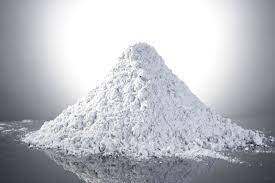
In the vast realm of industrial minerals, calcined kaolin stands out as a versatile and indispensable material. Derived from natural kaolin clay through a meticulous heating process, calcined kaolin offers a myriad of applications across various industries.
Kaolin, also known as china clay, is a naturally occurring clay mineral that is abundantly found in regions across the globe. It is primarily composed of kaolinite, a mineral with a fine particle size and a layered structure. The formation of kaolin is a result of the weathering and erosion of feldspar-rich rocks, such as granite.
Properties of Calcined Kaolin
Calcined kaolin exhibits a unique set of properties that contribute to its broad range of applications. These properties include:
a. High brightness: Calcination enhances the whiteness and brightness of kaolin, making it an ideal ingredient in paper, paints, and coatings.
b. Porosity: The heat-driven transformation of kaolin increases its porosity, rendering it suitable for use in catalysts, absorbents, and filtration media.
c. Increased opacity: The opacity of calcined kaolin makes it valuable in the production of ceramics, where it imparts a smooth and matte finish.
d. Chemical stability: Calcined kaolin is chemically inert and resistant to acids, alkalis, and other corrosive substances, making it useful in industries such as rubber, plastics, and adhesives.
e. Reinforcing properties: The fine particle size and platy structure of calcined kaolin contribute to its reinforcing capabilities in rubber, plastics, and composite materials.
Diverse Applications of Calcined Kaolin
The versatility of calcined kaolin enables its application across a wide range of industries, including:
a. Paper industry: Calcined kaolin serves as a coating pigment in paper production, enhancing paper smoothness, brightness, and opacity.
b. Paints and coatings: Due to its high brightness and opacity, calcined kaolin is used as an extender pigment in paints and coatings, improving their coverage, hiding power, and durability.
c. Ceramics industry: Calcined kaolin acts as a key ingredient in the production of ceramics, providing whiteness, fine particle size, and improved strength.
d. Rubber industry: Calcined kaolin is used as a reinforcing filler in rubber compounds, imparting strength, stiffness, and dimensional stability to rubber products.
e. Plastics industry: In plastics manufacturing, calcined kaolin enhances mechanical properties, reduces shrinkage, and improves surface quality.
f. Adhesives and sealants: The chemical stability and fine particle size of calcined kaolin make it an ideal ingredient in adhesives and sealants, improving performance and bonding characteristics.
g. Catalysts and absorbents: Calcined kaolin's porosity and high surface area make it valuable in catalysts, absorbents, and filtration media, aiding in various chemical processes.
h. Personal care products: Calcined kaolin finds application in personal care products, such as cosmetics and skincare formulations, where it acts as an absorbent and a bulking agent.
Nigeria, with its abundant kaolin deposits, presents a significant opportunity for entrepreneurs and investors interested in starting calcined kaolin production.
This article serves as a comprehensive guide, outlining the necessary steps and considerations involved in establishing a successful calcined kaolin production plant in Nigeria.
Understanding the Market Potential
Before delving into the process of setting up a calcined kaolin production facility, it is crucial to evaluate the market demand and potential profitability. Conduct thorough market research to identify the applications and industries that heavily rely on calcined kaolin. Analyze current market trends, competition, pricing, and consumer preferences. This information will help you make informed decisions and develop a robust business plan.
Conducting a Feasibility Study
A feasibility study is an essential step to assess the viability of your calcined kaolin production project. It involves evaluating factors such as raw material availability, infrastructure requirements, equipment needs, labor costs, regulatory compliance, and financial projections. Engage industry experts and consultants to conduct a comprehensive feasibility study, enabling you to make well-informed decisions and secure funding.
Acquiring Raw Materials
Nigeria is rich in kaolin deposits, particularly in states like Edo, Ogun, Plateau, and Katsina. Identify and secure reliable sources of high-quality kaolin ore for your production plant.
Establish partnerships with local miners or consider acquiring mining rights for a consistent supply of raw materials. Ensure that the kaolin ore meets the necessary quality specifications to produce high-grade calcined kaolin.
Setting up the Production Facility
To set up a calcined kaolin production plant, you need to consider several key factors:
a. Location: Choose a strategic location near the kaolin deposits to minimize transportation costs. Ensure the site has access to essential utilities such as water, electricity, and gas.
b. Plant Design: Engage experienced engineers and consultants to design a plant layout that optimizes workflow, productivity, and safety. Consider factors such as raw material handling, crushing, grinding, calcination, and product packaging.
c. Equipment: Invest in reliable and efficient machinery for the production process. This may include crushers, pulverizers, rotary kilns, classifiers, and packaging machinery. Ensure the equipment meets industry standards and has the necessary capacity to meet your production targets.
d. Infrastructure: Develop the necessary infrastructure, including buildings, storage facilities, laboratories, and waste management systems.
Calcination Process
The calcination process involves heating kaolin at high temperatures to remove impurities and transform it into metakaolin. The following steps outline the basic process:
a. Crushing and Grinding: The raw kaolin ore needs to be crushed and ground to a suitable particle size for optimal calcination.
b. Calcination: The crushed and ground kaolin is fed into a rotary kiln and heated at temperatures between 700-1000°C. This process removes chemically-bound water and transforms kaolin into metakaolin.
c. Cooling and Grinding: After calcination, the metakaolin is cooled and then further ground to achieve the desired particle size distribution.
d. Quality Control: Implement a stringent quality control system to ensure the final product meets the required specifications. Perform regular laboratory tests to analyze physical and chemical properties.
Regulatory Compliance
Ensure compliance with all relevant laws, regulations, and environmental standards. Obtain the necessary permits and licenses required for operating a calcined kaolin production plant. Comply with environmental regulations regarding waste management, emissions, and reclamation.
Marketing and Distribution
Develop a comprehensive marketing strategy to promote your calcined kaolin products. Identify potential customers and industries where your products can be utilized. Establish relationships with distributors, wholesalers, and end-users to ensure a smooth supply chain. Attend trade shows, industry conferences, and engage in targeted advertising to raise awareness about your product offerings.
Continuous Improvement and Innovation
To remain competitive in the calcined kaolin industry, focus on continuous improvement and innovation. Stay updated with the latest technological advancements, industry trends, and consumer demands. Invest in research and development to explore new applications and improve the quality of your products.
In conclusion, starting a calcined kaolin production venture in Nigeria presents a promising opportunity due to the country's rich kaolin deposits and diverse industrial applications.
However, success in this endeavor requires careful planning, feasibility studies, adherence to quality standards, and understanding the market dynamics. By following the steps outlined in this guide, aspiring entrepreneurs and investors can lay a solid foundation for a thriving calcined kaolin production plant in Nigeria.






















